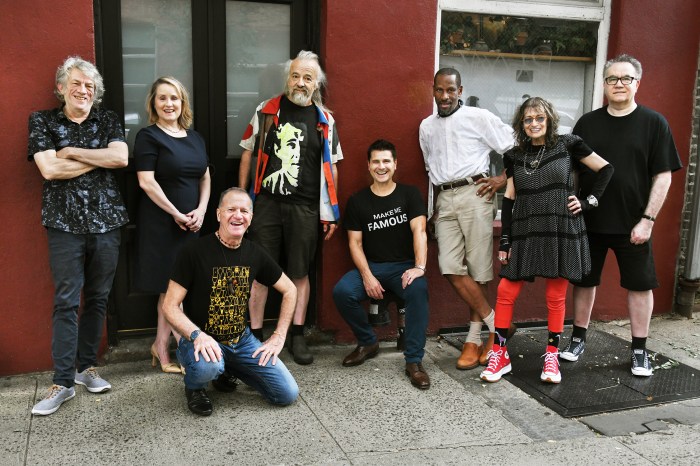By Jery Tallmer
The creative process is a fascinating creature, full of twists and turns, false starts, metamorphoses, germinations, quick deaths, aliases, disguises, regenerations, who knows what.
Horton Foote, he knows. He doesn’t know how, but he knows what.
Midway through “The Trip to Bountiful,” perhaps this master craftsman’s best known work, the elderly Mrs. Watts, on the run from her son and intolerable daughter-in-law, is riding on a bus toward her lovingly remembered (but no longer existent) small hometown of distant days and years.
She gets chatting with a young woman who has been kind to her at the bus station. The recently married young woman — her name is Thelma — is herself very upset because the husband she adores is a soldier somewhere far overseas.
“Lots of girls I know think I’m silly about him, but I can’t help it,” she says.
Suddenly Mrs. Watts blurts out: “I wasn’t in love with my husband” and goes on to tell about the man she really loved, Ray John Murray. “Even after my husband had died, and I had to move back with Mama and Papa, I used to sit on the front gallery [Texan for porch] every morning and every evening just to nod hello to Ray John Murray as he went by the house to work at the store. He went a block out of his way to pass the house. He never loved anybody but me.”
So much for Ray John Murray. That’s all that survives of that character.
In a tiny dressing room at the Signature Theatre on West 42nd Street, where “The Trip to Bountiful” is in a glowing new production through February 19, Pulitzer – and Oscar-winner Horton Foote said it was CBS “Playhouse 90” producer Fred Coe who had commissioned the first “Bountiful” into existence. (It entered life in 1953 as a TV drama starring Lillian Gish.)
“You always had to tell Fred in a few words what the play would be about. I never could do that, so I would write the entire play first. This one started when I thought of a great aunt I’d had [as a boy, back in Wharton, Texas] — a sweet woman who looked a lot like a grandmother.
“I was told by my mother, who was in on all the secrets, that this aunt had wanted to marry her first cousin, but the family didn’t like that. Instead, she married an older man, a riverboat captain, and had four children with him. When he died she moved back into her hometown, where she would sit on the porch and nod to the man she really loved as he came by her house every morning. By the time I came to know her, she was very poor and living with relatives.
“Well, I decided to start the play [for Fred Coe] with the day of her wedding to the riverboat captain. I wrote it, but it didn’t work. So all that’s left of that whole thing is where Mrs. Watts talks to the girl on the bus … ”
“That’s what he always does; that’s the way he works,” said Hallie Foote, Horton’s daughter, who was jammed into the only remaining inch of this dressing room.
It was and is, in fact, her dressing room. To the Mrs. Watts of Lillian Gish and (in the 1985 movie) the unforgettable Geraldine Page, we must now add the crushed-velvet steel of Lois Smith, in concert with Hallie Foote, who plays bad-tempered Jessie Mae, the intolerable daughter-in-law. Devon Abner (Hallie’s real husband) appears as Mrs. Watt’s betwixt-two-fires son Ludie; Meghan Andrews as Thelma; and Gene Jones, Sam Kitchen, Frank Girardeau, Jim Demarse are in supporting roles.
Horton has already had an entire season of his plays at the Signature. “I didn’t want just any kind of theater doing it [‘Bountiful’] now, you know,” he said of this 50 + 3 years anniversary production directed by Harris Yulin. “Mrs. Watts, the old woman” — said Texas and Greenwich Village’s young Horton Foote, four months shy of his 90th birthday — “is a very difficult part. Geraldine kind of set the standard. She won the Academy Award and I got a nomination. So our real search now was to find a Mrs. Watts … ”
“And Lois Smith was the one Horton always wanted,” said Hallie Foote, completing her father’s sentence. Her own role — an uptight, unpleasant control freak whose forgetful, hymn-singing mother-in-law drives her nuts — isn’t all that easy, either. There is one moment of snarling, lightning-bolt conflict between Mrs. Watts and Jessie Mae that will raise the skin on your neck.
“It is hard,” Ms. Foote said of the character she plays. “The temptation is to make it into caricature. But if you look at it, the three of them” — son, daughter-in-law, and Mrs. Watts — “shut up in this one little apartment, Jessie Mae’s husband [the son] not working, and she having to care for his mother — well, I tried to find the human side of Jessie Mae … ”
“And every time she” — said Horton, pokerfaced, with a glance toward his daughter — “does something like Jessie Mae, I remind her … ”
“And yes, dad sings hymns around the house” — that house, or apartment, being the same one far west on Horatio Street that Horton and the late Lillian Valish Foote, his wife, Hallie’s mother, lived in for years.
Say, Hallie, how many of your father’s plays have you been in?
She hid her eyes.
“What do you think?” she asked her father. “Fourteen or fifteen, at least.”
“And the films,” he said. “At least five films.” Among them, “1918,” “On Valentine’s Day,” “Courtship,” “Convicts,” and, yes, “The Trip to Bountiful.”
Hallie Foote’s next project will be to raise money for and produce a Robert Altman film of Horton Foote’s “The Widow Claire.” She and Matthew Broderick had been in it on stage. “Now we’re too old.”
Horton Foote has just finished his next project, his third original — as opposed to adapted — screenplay [the other two were “Alone” and “Tender Mercies”].
“I call it his environmental film,” said daughter Hallie.
Here’s another idea, Horton. Maybe you could go back and tell us whatever became of Ray John Murray.





































